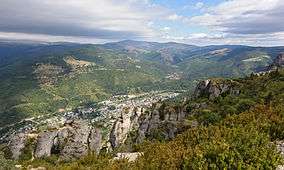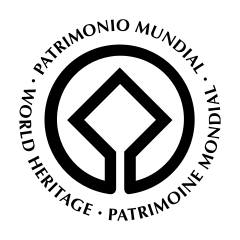Causses and Cévennes
The Causses and the Cévennes, Mediterranean agro-pastoral Cultural Landscape (French: Les Causses et Les Cévennes, paysage culturel de l'agro-pastoralisme méditerranéen) is a UNESCO World Heritage site[1] located in the southern part of central France with over three millennia of agro-pastoral history.
| UNESCO World Heritage Site | |
|---|---|
 Florac and the Cévennes National Park seen from Causse Méjean | |
| Official name | The Causses and the Cévennes, Mediterranean agro-pastoral Cultural Landscape |
| Location | Massif Central, France |
| Criteria | Cultural: (iii), (v) |
| Reference | 1153rev |
| Inscription | 2011 (35th session) |
| Area | 302,319 ha (747,050 acres) |
| Buffer zone | 312,425 ha (772,020 acres) |
| Website | www |
| Coordinates | 44°13′13″N 3°28′23″E |
 Location of Causses and Cévennes in France | |
The region is mountainous with numerous narrow valleys, making conditions poorly suited to host cities, but well-suited for pastoralism. Consequently, the landscape of Causses and Cévennes evolved over time to reflect all types of Mediterranean agro-pastoral systems. The Causses and the Cévennes retain numerous testimonies of this evolution of pastoralism over time. Mont Lozère is one of the last places where summer transhumance is still practiced in the traditional way.[2]
Inscription criteria
The site was inscribed on the list in 2011 by the World Heritage Committee at its 35th session in Paris, France. The site was inscribed on the basis of Criterion (iii), "bearing unique testimony to a cultural tradition",[3] as it is an outstanding example of Mediterranean agro-pastoralism, and Criterion (v), "an outstanding example of human interaction with the environment",[3] as the landscape demonstrates the way the system has developed over millennia.[2]
Inscription history
The site was originally added to France's Tentative List in 2002 and was considered for inscription by the Committee at its 30th session in Vilnius, Lithuania under criteria (v) and (vi).[4] ICOMOS recommending deferring inscription. France framed Criterion (v) for the site as being the "last bastion of the agropastoral system in Western Europe"[5] while ICOMOS considered this to not be the case. Criterion (vi) was framed as the site "keeps alive the memory of episodes related to the diffusion of French Protestantism, fights with the Catholic Church, and the development of ideas of liberty and freedom".[5] ICOMOS considered that this element was not of universal significance, but of national significance only as sites elsewhere in Europe also testify to the persecution of Protestants and the impact thereof on national history. In 2009, ICOMOS also requested that France justify the boundary of the property and provide a basis for managing and sustaining the site's agro-pastoral traditions.[6] When France resubmitted its nomination file, focus was laid on the historic aspect of pastoralism and its impact to the site's cultural development, while reference to the site's testament to historical events, Criterion (vi), was dropped.[7] The site successfully inscribed on the World Heritage List in 2011.
References
- "Causses Cévennes, candidate for inclusion in the World Heritage List". Loire Valley World Heritage. 5 June 2009. Retrieved 11 October 2013.
- "The Causses and the Cévennes, Mediterranean agro-pastoral Cultural Landscape". World Heritage Convention.
- "The Criteria for Selection". World Heritage Convention.
- "Evaluation of Cultural Properties WHC-06/30.COM/INF.8B.1" (PDF). World Heritage Convention.
- Evaluation of Cultural Properties WHC-06/30.COM/INF.8B.1, pg. 100.
- "Report on Decisions 33COM 8B.3, Decision: 33 COM 8B.32" (PDF). World Heritage Convention.
- "'Les Causses et les Cévennes paysage Culturel de l'agro-pastoralisme méditerranéen: Candidature à l'inscription sur la liste du patrimoine mondial de l'UNESCO'" (PDF). World Heritage Convention.
